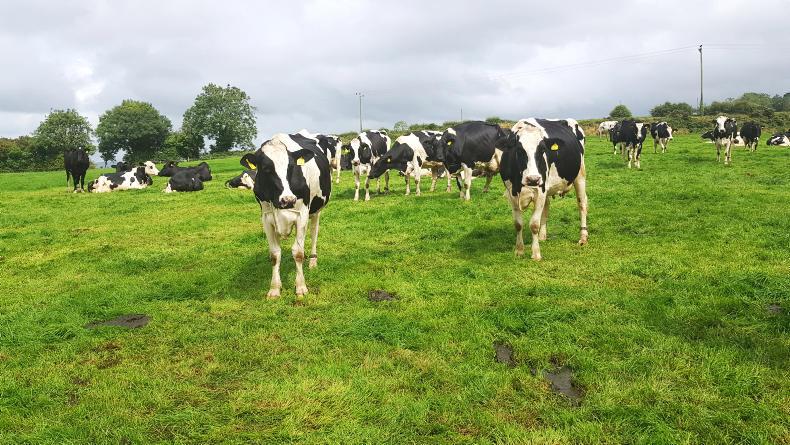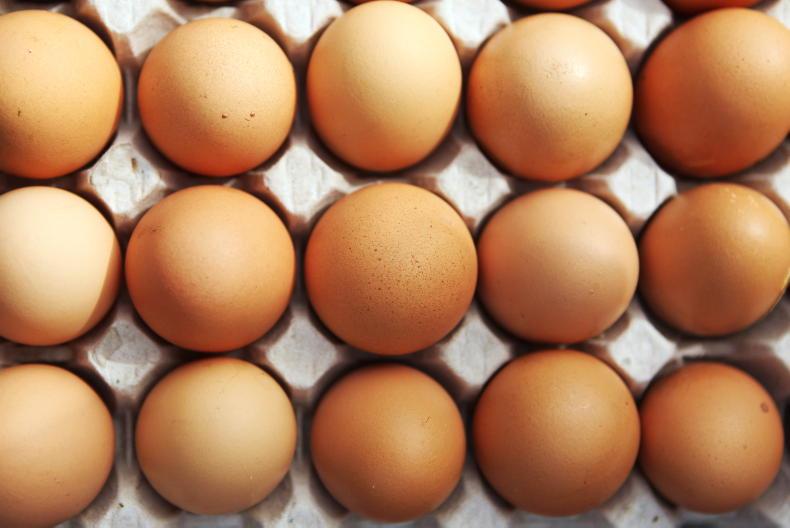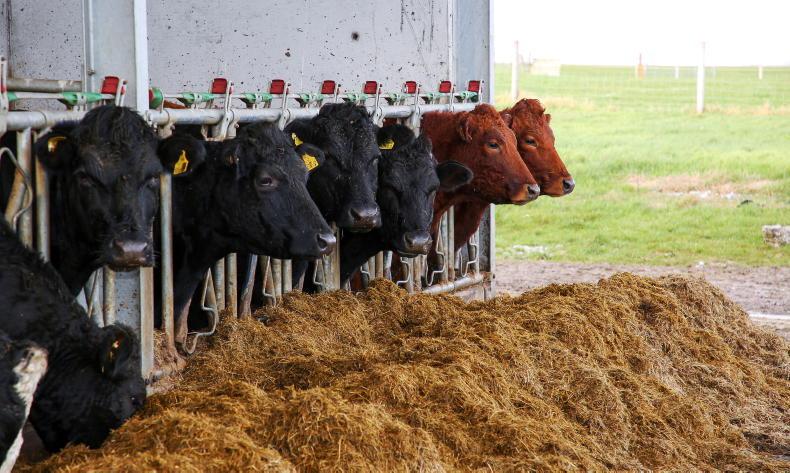Most Dairylink Ireland programme farmers have started using selective dry cow therapy where certain cows do not get antibiotic dry cow tubes and only get a teat sealer at the end of lactation.
Speaking at the National Milk Records open day near Derry earlier this month, Norman Beggs from Udder Health Solutions said that the cut-off thresholds for determining which cows are suitable for selective dry cow therapy should be specific to individual dairy herds.
He advised farmers to not consider using selective dry cow therapy at all in their herd if bulk milk somatic cell count (SCC) has been above 250,000/ml in the last year. If SCC has been consistently high, then veterinary advice should be sought in areas such as treating high cell count cows, reviewing milking routine and parlour and cubicle house hygiene.
If a herd is eligible to use selective dry cow therapy, Beggs said that the cut-off thresholds for determining which cows are suitable depends on a range of parameters such as bulk milk SCC, dry period mastitis infection rate and early lactation infection rate.
In general, the lower the bulk SCC and mastitis infection rates, the lower the selective dry cow therapy cut off thresholds.
For example, Dairylink Ireland participant Richard Marshall usually gives teat sealer only to cows that have had no cases of mastitis and have had a SCC under 150,000/ml during the last lactation.
Beggs said that thresholds for individual farmers should be determined in consultation with a vet and should be regularly reviewed.
He said that regular milk recording was essential for having accurate and up-to-date information for the SCC of individual cows.
In the case of Richard Marshall, he milk-records once a month, with a morning milking done one month and an afternoon milking the following month.
Weekly round-up
Ground conditions deteriorated on some Dairylink Ireland farms after heavy downpours, with grazing becoming tricky last week.Colder temperatures have also meant grass growth has slowed up in recent days.Programme farmers with autumn-calving cows are continuing to dry them off and preparations are also being made for calving.Some Dairylink farmers have been making third-cut silage and reseeding over the past week.Farmer focus: Richard Marshall, Omagh, Co Tyrone
There are 85 cows going through the parlour on Richard Marshall’s farm near Omagh, Co Tyrone. Calving begins in early September and 35 cows are dried off at present, with another eight due for drying off at the end of the week.
The aim is to have an eight-week dry period, with heifers getting another week or two longer. Any cow yielding less than 12 litres is also dried off early, as well as cows that are below target condition score of 2.75.
Selective dry cow therapy is carried out on the Marshall farm. Records of breeding, scanning, mastitis cases and milk recording (based on one milking each month) is sent to a local vet.
Richard then receives a list of cows that are due for drying off over the next few weeks, with a recommended treatment given for each cow. In general, cows with no cases of mastitis and a somatic cell count under 150,000/ml get teat sealer only.
Bulk tank somatic cell count is low on the farm and usually sits around 70,000/ml, which allows milk quality bonus payments. Milking routine involves cows getting a chlorhexidine teat spray and wipe before clusters are attached. An iodine spray is then used after milking.
A few years ago, any cow with a somatic cell count above 200,000/ml had milk samples tested and a treatment plan was drawn up with a local vet. This generally involved cows being treated with antibiotics or else earmarked for culling.
Settings for automatic cluster removers were also adjusted, as the vet thought that units were staying on cows too long.
Allocating grass
Richard managed to keep cows at grass last week, despite heavy rain affecting ground conditions. Extra entry points to paddocks, which were added early this year, allowed him to keep grazed grass in cows’ diets, while limiting poaching in high-traffic areas.
The milking herd is currently averaging 22 litres from 4.5kg of concentrates. In-parlour feeders are set so all cows get 2.5kg, with feed to yield given above 16 litres. A bale of silage is also fed out before evening milking each day.
Although Richard is happy with post-grazing residual covers, cow body condition and dung consistency at present, protein levels have dropped recently, which has led him to question whether cows are getting enough energy intake from grazed grass.
A quick calculation by Dairylink Ireland adviser Aidan Cushnahan suggests cows should be allocated just over one hectare per day, which is slightly more than they were previously getting.
Aidan said that this is based on a daily demand of 18kg DM/cow, with 4kg DM/cow being met from meal and 3kg DM/cow from silage. This leaves a requirement of 11kg DM/cow from grass, which equates to 935kg DM across the 85-cow herd.
Cows are taking 900kg DM/ha from grass, as the plate meter shows that pre-grazing covers are currently at 2,600kg DM/ha and residuals are at 1,700kg DM/ha. Dividing grass demand of 935kg DM into the grass supply of 900kg DM/ha means 1.04ha is required daily at present.
Read more
Managing wet conditions in Tyrone
Dairylink: a beginner’s guide to budgeting grass
Most Dairylink Ireland programme farmers have started using selective dry cow therapy where certain cows do not get antibiotic dry cow tubes and only get a teat sealer at the end of lactation.
Speaking at the National Milk Records open day near Derry earlier this month, Norman Beggs from Udder Health Solutions said that the cut-off thresholds for determining which cows are suitable for selective dry cow therapy should be specific to individual dairy herds.
He advised farmers to not consider using selective dry cow therapy at all in their herd if bulk milk somatic cell count (SCC) has been above 250,000/ml in the last year. If SCC has been consistently high, then veterinary advice should be sought in areas such as treating high cell count cows, reviewing milking routine and parlour and cubicle house hygiene.
If a herd is eligible to use selective dry cow therapy, Beggs said that the cut-off thresholds for determining which cows are suitable depends on a range of parameters such as bulk milk SCC, dry period mastitis infection rate and early lactation infection rate.
In general, the lower the bulk SCC and mastitis infection rates, the lower the selective dry cow therapy cut off thresholds.
For example, Dairylink Ireland participant Richard Marshall usually gives teat sealer only to cows that have had no cases of mastitis and have had a SCC under 150,000/ml during the last lactation.
Beggs said that thresholds for individual farmers should be determined in consultation with a vet and should be regularly reviewed.
He said that regular milk recording was essential for having accurate and up-to-date information for the SCC of individual cows.
In the case of Richard Marshall, he milk-records once a month, with a morning milking done one month and an afternoon milking the following month.
Weekly round-up
Ground conditions deteriorated on some Dairylink Ireland farms after heavy downpours, with grazing becoming tricky last week.Colder temperatures have also meant grass growth has slowed up in recent days.Programme farmers with autumn-calving cows are continuing to dry them off and preparations are also being made for calving.Some Dairylink farmers have been making third-cut silage and reseeding over the past week.Farmer focus: Richard Marshall, Omagh, Co Tyrone
There are 85 cows going through the parlour on Richard Marshall’s farm near Omagh, Co Tyrone. Calving begins in early September and 35 cows are dried off at present, with another eight due for drying off at the end of the week.
The aim is to have an eight-week dry period, with heifers getting another week or two longer. Any cow yielding less than 12 litres is also dried off early, as well as cows that are below target condition score of 2.75.
Selective dry cow therapy is carried out on the Marshall farm. Records of breeding, scanning, mastitis cases and milk recording (based on one milking each month) is sent to a local vet.
Richard then receives a list of cows that are due for drying off over the next few weeks, with a recommended treatment given for each cow. In general, cows with no cases of mastitis and a somatic cell count under 150,000/ml get teat sealer only.
Bulk tank somatic cell count is low on the farm and usually sits around 70,000/ml, which allows milk quality bonus payments. Milking routine involves cows getting a chlorhexidine teat spray and wipe before clusters are attached. An iodine spray is then used after milking.
A few years ago, any cow with a somatic cell count above 200,000/ml had milk samples tested and a treatment plan was drawn up with a local vet. This generally involved cows being treated with antibiotics or else earmarked for culling.
Settings for automatic cluster removers were also adjusted, as the vet thought that units were staying on cows too long.
Allocating grass
Richard managed to keep cows at grass last week, despite heavy rain affecting ground conditions. Extra entry points to paddocks, which were added early this year, allowed him to keep grazed grass in cows’ diets, while limiting poaching in high-traffic areas.
The milking herd is currently averaging 22 litres from 4.5kg of concentrates. In-parlour feeders are set so all cows get 2.5kg, with feed to yield given above 16 litres. A bale of silage is also fed out before evening milking each day.
Although Richard is happy with post-grazing residual covers, cow body condition and dung consistency at present, protein levels have dropped recently, which has led him to question whether cows are getting enough energy intake from grazed grass.
A quick calculation by Dairylink Ireland adviser Aidan Cushnahan suggests cows should be allocated just over one hectare per day, which is slightly more than they were previously getting.
Aidan said that this is based on a daily demand of 18kg DM/cow, with 4kg DM/cow being met from meal and 3kg DM/cow from silage. This leaves a requirement of 11kg DM/cow from grass, which equates to 935kg DM across the 85-cow herd.
Cows are taking 900kg DM/ha from grass, as the plate meter shows that pre-grazing covers are currently at 2,600kg DM/ha and residuals are at 1,700kg DM/ha. Dividing grass demand of 935kg DM into the grass supply of 900kg DM/ha means 1.04ha is required daily at present.
Read more
Managing wet conditions in Tyrone
Dairylink: a beginner’s guide to budgeting grass









SHARING OPTIONS